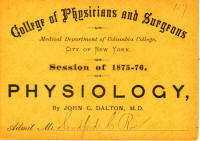John Call Dalton, M.D.
Click image to enlarge
DALTON, John Call, physiologist, born in Chehnsford, Massachusetts, 2 February 1825. He was graduated at Harvard in 1844, and at the medical department of that University in 1847. His attention was at once directed to physiology, and in 1851 he obtained the annual prize offered by the American medical association by his essay on "Corpus Luteum." Subsequently his researches on the anatomy of the placenta, the physiology of the cerebellum, intestinal digestion, and other experimental observations, embodied in his treatise on physiology, gained for him a reputation as one of the first of modern physiologists. He became professor of physiology in the medical department of the University of Buffalo, and was the first in the United States to teach that subject with illustrations by experiments on animals. This chair he resigned in 1854, and accepted a similar professorship in the Vermont medical College in Woodstock, where he remained until 1856. From 1859 till 1861 he filled the chair of physiology in the Long Island College hospital in Brooklyn. During the winter of 1854-'5 he lectured on physiology at the College of physicians and surgeons, New York, temporarily filling the place of Dr. Alonzo Clark. In 1855 he was elected to that professorship, which he continued to fill until his resignation in 1883. In 1884 he again succeeded Dr. Clark as president of the College of physicians and surgeons.
During the civil war he was a surgeon in the national service, going to Washington in 1861 in that capacity with the 7th New York regiment. Subsequently he was appointed surgeon of volunteers, and held important offices in the medical corps until his resignation in March 1864. Dr. Dalton has been an active member of many medical societies, and held prominent offices in them. In 1864 he was elected a member of the National academy of sciences. His contributions to the literature of physiology have been numerous since 1851. He has published articles in the "American Journal of the Medical Sciences," the "Transactions of the New York Academy of Sciences," the "American Medical Monthly," and other medical journals in New York; and also many valuable articles in his specialties in the American and other cyclopaedias. He has published in book-form "A Treatise on Human Physiology" (New York, 1859; 6th ed., 1882);" A Treatise on Physiology and Hygiene for Schools, Families, and Colleges" (1868); "The Experimental Method of Medicine" (1882); "Doctrines of the Circulation" (1884); and "Topographical Anatomy of the Brain" (1885) .
His brother, Edward Barry Dalton, physician, born in Lowell, Massachusetts, 21 September 1834 ; died in Santa Barbara, California, 13 May 1872, was graduated at Harvard in 1855, and at the College of physicians and surgeons, New York, in 1858. Dr. Dalton then settled in New York, and was resident physician of St. Luke's hospital when the civil war began. He at once volunteered as a surgeon, and served from April 1861, till May 1865. At first he was a medical officer in the navy, after which he was commissioned surgeon of the 36th New York volunteers, and subsequently surgeon of U. S. volunteers, serving as medical inspector of the 6th army corps, and as medical director of the Department of Virginia. In March 1864, he was transferred to the Army of the Potomac, where he remained throughout the campaign of that year, from the Wilderness to City Point, having charge of all the wounded, and establishing and moving the hospitals. At City Point he was made chief medical officer of the depot field-hospitals, Army of the Potomac, till the final campaign in March and April 1865, when he accompanied the troops as medical director of the 9th army corps. After his discharge he was successively appointed brevet lieutenant colonel and colonel of volunteers.
In March 1866, he was appointed sanitary superintendent of the New York metropolitan board of health, in which office he remained until his resignation in January 1869. In 1869 he originated the present City ambulance system for the transportation of the sick and injured. His health had then begun to fail, and, after trying various resorts, he finally visited California, where he died from consumption. He published papers on "The Disorder known as Bronzed Skin, or Disease of the Supra-renal Capsules" (1860); "The Metropolitan Board of Health" (1868); and "Reports of the Sanitary Superintendent of the Metropolitan Board of Health" from 1866 till 1869.
Edited Appletons Encyclopedia, Copyright © 2001 VirtualologyTM__________________
Before the discoveries of John Call Dalton, Jr., MD (1824–1889), innervation of laryngeal muscles, long-term effects of cerebellar lesions, and consequences of raised intracranial pressure were poorly understood. Dalton discovered that the posterior cricoarytenoid muscles adducted the vocal cords during inspiration. He confirmed Flourens’ observations that acute ablation of the cerebellum of pigeons caused loss of coordination. Dalton observed that properly cared for pigeons gradually recovered "coordinating power." Dalton observed that prolonged raised intracranial pressure caused tachycardia and then fatal bradycardia in dogs. Before Dalton published his photographic atlas of the human brain, neuroanatomy atlases were sketched by Europeans and imported into the United States. Dalton’s atlas of the human brain contained precise photographs of vertical and horizontal sections that equal modern works. Before Dalton introduced live demonstrations of animals, physiology was taught by recitation of texts only. Dalton was the first American-born professor to teach physiology employing demonstrations of live animals operated on under ether anesthesia. He wrote an essay advocating experimentation on animals as the proper method of acquiring knowledge of function and that humane animal experimentation would ultimately improve the health of man and animals. His eloquent advocacy for humane experimental physiology quelled attacks by contemporaneous antivivisectionists. Dalton was America’s first experimental neurophysiologist.
